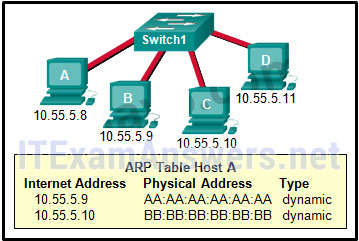Question:
Refer to the exhibit. A switch with a default configuration connects four hosts. The ARP table for host A is shown. What happens when host A wants to send an IP packet to host D?

- Host A sends an ARP request to the MAC address of host D.
- Host D sends an ARP request to host A.
- Host A sends out the packet to the switch. The switch sends the packet only to the host D, which in turn responds.
- Host A sends out a broadcast of FF:FF:FF:FF:FF:FF. Every other host connected to the switch receives the broadcast and host D responds with its MAC address.
Explanation: Whenever the destination MAC address is not contained within the ARP table of the originating host, the host (host A in this example) will send a Layer 2 broadcast that has a destination MAC address of FF:FF:FF:FF:FF:FF. All devices on the same network receive this broadcast. Host D will respond to this broadcast.
Exam with this question: CCNA 1 (v5.1 + v6.0) Chapter 5 Exam Answers
Exam with this question: CCNA 2 v6.0 - CCENT (ICND1) Practice Certification Exam
Exam with this question: Networking Basics Course Final Exam
Please login or Register to submit your answer
